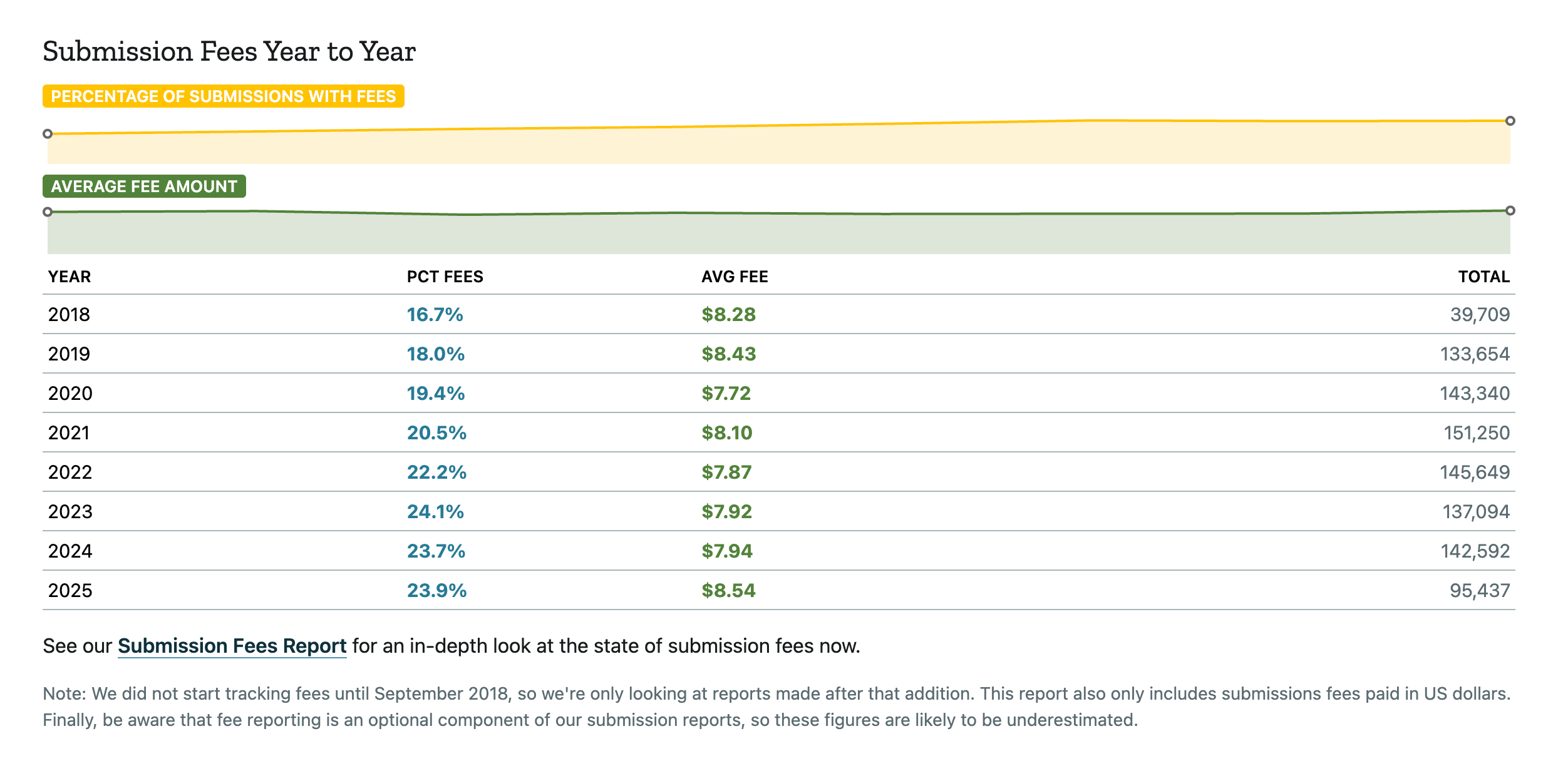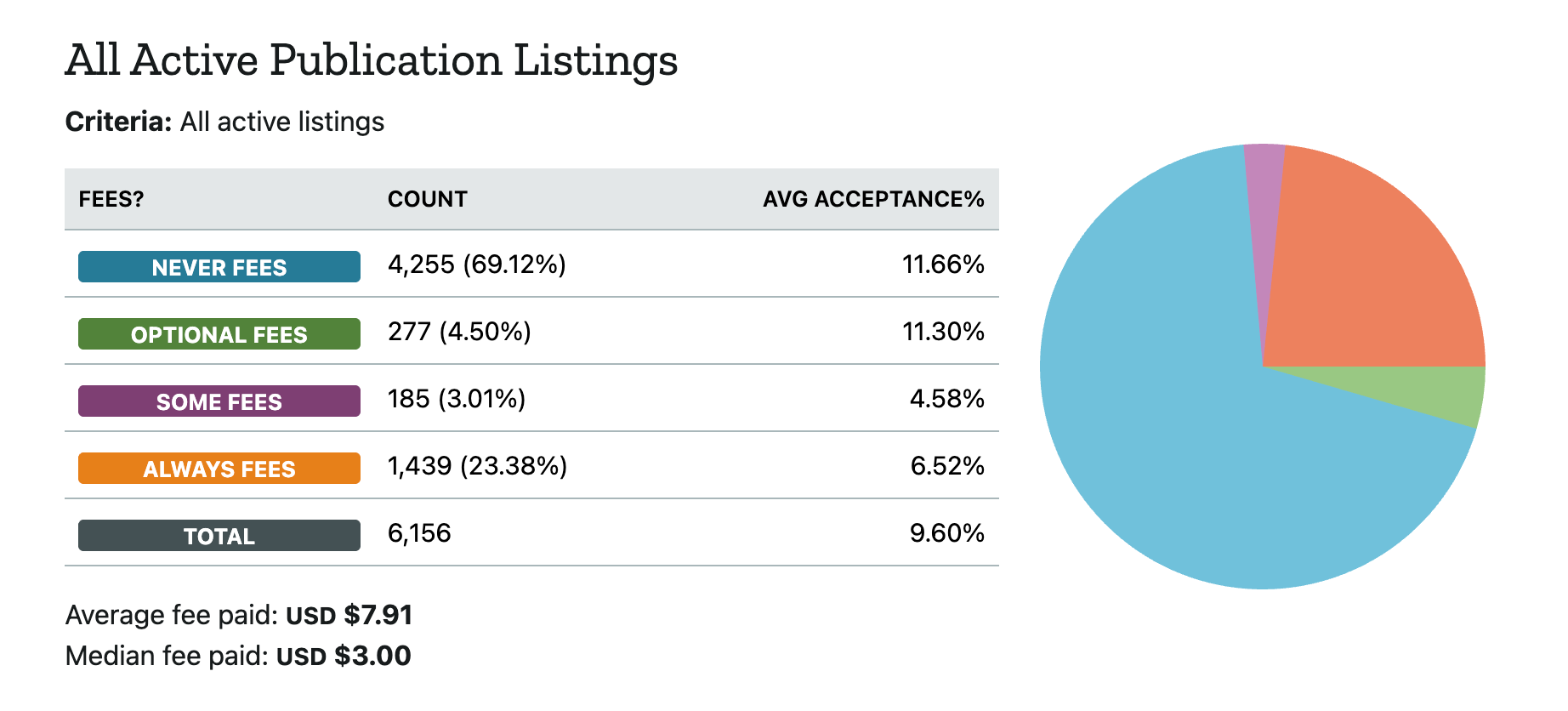Submission Fees in Literary Publishing: Finding the Right Balance

The debate over submission fees in literary publishing touches on fundamental questions about accessibility, sustainability, and the value of creative work. Some publications charge, others don’t. Some ask for donations, offer tip jars or just a coffee in return for their review time. The decision is a big one and impacts both publications and writers so let's take a look at whether or not you should charge and importantly, how much.
Should Literary Agents Charge Reading Fees?
In a word No - literary agents should not charge reading fees and if they do, it's generally a red flag to the writer.
Why?
- Book deals lead to a commission which is where any revenue is made.
- This aligns an agent’s incentives with a writer - they only make money if the author does.
Agents who charge reading fees are often considered predatory
- This includes fees just to read your manuscript, assess it, or consider representation.
- Scammers operate under the guise of being "agents" but make their money solely off authors through such fees.
Industry authorities agree:
- The Association of American Literary Agents (AALA) strictly prohibits its members from charging reading fees.
- Writer advocacy groups like Writer Beware and SFWA (Science Fiction and Fantasy Writers Association) warn writers to avoid any agent charging fees upfront.
What about Submission Fees for Literary Magazines?
Literary magazines are very different from literary agents and where once the practice of charging for a submission was an aberration, it's quickly becoming an accepted practice for magazines. And for many, it's understandable; today they operate in a challenging environment where traditional funding sources are increasingly scarce. Submission fees go a long way to providing a consistent revenue stream that can be relied upon to help keep the lights on. Benjamin Davis, the co-founder of Chill Subs, a leading magazine database and community for writers, recently wrote an excellent piece for Literary Hub detailing the economics of submission fees and the proliferation within the industry. Some stats:
- 13% of literary magazines using Chill Subs charge fees.
- 24% of Brecht De Poortere’s top 1000 magazines charge fees.
- 56% of the top 100 most popular magazines charge fees.
Duotrope, another leading magazine database, recently released some interesting data showing the average fee coming in at around $3.50 and when adding contests into the mix (which often charges much higher fees) this number can rise to around $8. The graph below shows a steady rise in fees and over the last few years and it's only set to continue growing. A full report they update regularly can be found here.


The Case for Submission Fees
Financial Sustainability
Running a literary magazine involves numerous costs that often go unrecognised:
- Editorial staff compensation.
- Digital infrastructure maintenance.
- Marketing and promotion.
- Production costs (for print publications).
- Submission management software.
Quality Control
Implementing a nominal fee can actually increase the volume of submissions due to the perception that the publication is higher quality and that's where everyone else is submitting. It can also:
- Reduce spam submissions.
- Filter out any inappropriate submissions
- Encourage writers to submit their best work.
- Help cover administrative costs.
- Support fair payment for contributors.
Professional Development
Fees can enable magazines to:
- Provide detailed feedback.
- Offer editorial mentorship.
- Maintain higher acceptance rates.
- Pay contributors professional rates.
The Case Against Submission Fees
Accessibility Concerns
Submission fees can immediately exclude those of lesser means from submitting, particularly in countries with lower economic wealth.
- Create barriers for marginalised voices.
- Disadvantage emerging writers.
- Limit diversity in literary publishing.
- Perpetuate existing inequities.
Ethical Considerations
Critics argue that:
- Writers shouldn't pay to have their work considered.
- Fees can exploit desperate writers.
- The model may favour privileged voices.
- Alternative funding sources should be explored.
Finding Middle Ground: A Hybrid Approach
Many successful literary magazines have adopted nuanced approaches that balance sustainability with accessibility and fee waivers. It's important to note that if offering fee waivers, its not hidden away, buried in the guidelines or the process in which a waiver is requested is onerous. Make it easy, accessible and free from any stigma. This approach might be abused by a very small minotity but the upside will be a new group of loyal advocates and supporters. Here are some other ways to offer a hybrid approach:
Tiered Submission Options
- Standard Free Submissions
- Longer response times.
- Basic editorial feedback (if any).
- Standard consideration.
- Premium Paid Submissions
- Expedited response times.
- Detailed editorial feedback.
- Special consideration for themed issues.
Strategic Fee Implementation
- Fee-free submission periods.
- Waiver programs for marginalised writers.
- Member/subscriber benefits.
- Tiered pricing based on submission type.
Setting the Right Price
When implementing submission fees, consider these factors:
Market Analysis
- Research comparable publications.
- Understand your target audience.
- Consider your publication's prestige.
- Evaluate your unique offering.
Cost Calculation
Try and factor in the following:
- Platform fees.
- Payment processing costs (Dapple is 2.9% + $0.65 or Submittable is a higher 5% + $0.99).
- Staff time and resources.
- Additional services offered such as marketing tools.
Recommended Fee Structure
Based on industry standards and operational costs:
Basic Submissions:
- $2-5 for standard submissions.
- $Free or discounted designated periods.
- Fee waivers for specific groups such as low-income.
Premium Services:
- $10-15 for expedited review.
- $10-25 for detailed feedback.
- $10-30 for specialised submissions such as one off contests with judges/prizes etc.
Implementation Best Practices
It goes without saying, if you offer expedited or detailed feedback, deliver on this promise! If a writer spends hours crafting a piece for a submission call and then shells out a tidy sum for a detailed feedback, do not send back a standardised rejection template 6 months later. This type of exploitation will lead to angry writers and your reputation as a legitimate business will be in jeopardy.
If running a contest, make sure this is an actual contest rather than a glorfied regular submission. A growing trend is for publications to slap a "contest" label on a regular submission call and charge more for it. Again, this type of behaviour is unethical and it will be quickly found out by those submitting. Chill Subs for example now have a Contest Calculator which tries to highlight the viability of contests by using writer feedback to assign scores and thus highlighting any bad actors.
Clear Communication
- Explicitly state where fees go.
- List any fees in the submission guidelines at the start of a submission form.
- Conversely, don't ambush a creator at the end of a form with a fee.
- Tip jars should be optional.
- Explain value-added services.
- Detail alternative submission options.
- Maintain transparency about the process.
- Give contactable information so that creators can reach out if queries or issues.
- Make sure you have a clear masthead to reinforce legitimacy.
Technology Integration
Using a submission management platform such as Dapple, you can:
- Set up multiple projects with different pricing.
- Automate fee collection.
- Track submission analytics.
- Manage fee waivers efficiently using private links.
- Encourage creators to reach out if they have a financial inability to pay fees
Regular Assessment
Monitor and evaluate:
- Submission volume and quality.
- Revenue vs. operational costs.
- Writer feedback and satisfaction.
- Impact on diversity metrics.
Making It Work with Dapple
Dapple provides flexible tools to implement your chosen fee structure:
- Customisable Fee Settings
- Set different fees for different projects.
- Create public and private projects for selective free entry.
- Track fee-related analytics.
- Secure Payment Processing
- Connect to your own Stripe account in a couple of easy steps.
- Payments appear immediately in your account.
- Automated receipt generation.
- Transparent fee breakdown.
- Simplified accounting.
- Enhanced Value Delivery
- Automated submission tracking.
- Integrated feedback systems.
- Status update notifications.
- Analytics and reporting.
Conclusion: A Balanced Approach
The decision to charge submission fees isn't binary. Success lies in finding a model that:
- Supports your publication's sustainability.
- Maintains accessibility.
- Provides value to writers.
- Aligns with your mission.
- Is fair to both you and those submitting material.
Whether you choose to implement fees or not, the key is to make an informed decision based on your specific circumstances and community needs. Dapple's flexible platform supports whatever approach you choose, helping you focus on what matters most: discovering and sharing great literature.
Want to explore how Dapple can help implement your ideal submission fee structure? Create an account for free or book a demo to learn more!